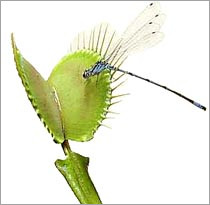DK Nature: Plants
Plants are one of the five kingdoms of living things. They are made up of many cells and are usually rooted in soil. Their green leaves capture sunlight to make food by PHOTOSYNTHESIS, providing food either directly or indirectly for most other living things on Earth, as well as life-giving oxygen.

The carnivorous Venus flytrap, which grows in very poor soils, takes essential minerals from insects. The ends of the plant’s leaves form a trap of two pads. If an insect lands on the pads, the trap snaps shut. The plant digests the insect and absorbs its minerals.
Plants cannot move around like animals, but they still show movements. Shoots grow; leaves turn toward the Sun. If a plant has flowers, they open and close. Climbing plants have fine tendrils, or stems, that reach out until they find something firm to grip onto.
Trees are the biggest of all plants. They grow so large because they are supported by a woody trunk that increases in width as the tree grows taller. The tallest tree, and the biggest living thing, is the Californian coast redwood, which reaches over 360 ft (110 m).
Plants have roots for two main reasons. Roots anchor the plant in the soil, and prevent it from being blown away by strong winds. They also take up water and minerals, such as nitrogen and sulfur, from the soil. Plants need water to replace that lost by TRANSPIRATION, and minerals to make substances essential for life.
Plants cannot escape from hungry plant-eaters, but they have evolved a wide range of defenses. Some have thorns or spines that cut into an animal’s skin and will pierce its mouth if eaten. Others produce chemicals that taste terrible and may be poisonous. Some have tiny hairs on their leaves that stop leaf-eating insects from reaching the leaf’s surface.
So far, scientists have identified over 300,000 species of plants. These are divided into two groups:
| Plants that reproduce using spores, including mosses, ferns, horsetails, and four other phyla. |
| Plants that reproduce using seeds, including flowering plants and conifers. |
Animals have to find and eat food, but plants are able to make their own by using sunlight energy. This process, called photosynthesis, provides plants with the energy and raw materials for growth.
Leaves constantly lose water by evaporation through tiny pores, or stomata, that also let carbon dioxide into, and oxygen out of, the leaf. This water loss, called transpiration, creates a force that helps draw up more water from the roots.
Water and nutrients are moved through a plant by its vascular system. This consists of two types of microscopic tubes—xylem and phloem. Xylem carries water and minerals from the roots to the rest of the plant. Phloem carries nutrients, such as glucose, from where they are made to other parts of the plant.
